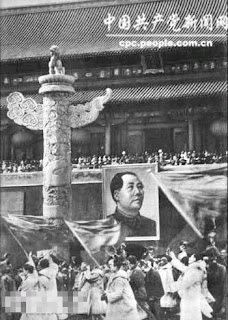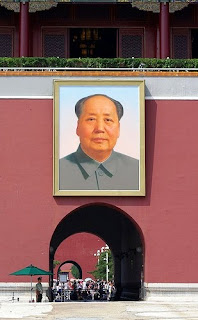TIENANMEN
The history of Mao Zedong as the Portrait hung overnight in the City wall


Most people think much about Mao Zedong.
From being dubbed as "The Great Helmsman", "Teacher", "Poet", "Guerilla leader" to "Dictator" and "Murderer", this man, steered China to its greater heights as a modern state guided by his thought and of course, the will of the people.
But despite these, he is recognized much as the man in Tienanmen square, as this portrait, being hung overnight in the gate leading to the city wherein was "Forbidden."
But at first, let us know about the Timeline on how this his portrait hung and be remembered by many as "The Great Helmsman", "Teacher" who guides his people.

In fact, very few people remember that Mao was not the first Chinese leader to appear in such hagiographical form on the Tiananmen Square. Sun Yat-sen, founder of Modern China and Husband of acting President of the People's Republic Soong Qingling, was remembered by a giant portrait erected in the square erected in 1925. And on 1945, after the war, A portrait of Premier and Generalissimo Chiang Kai-Shek, was also erected.
Mao's portrait was hung after the liberation of Beijing by the Red Army. At first, a hastily sketched portrait was hung in February. Then, on October 1, also known as the National Day, when Mao declared the founding of the People's Republic of China from the rostrum at Tiananmen Gate, an official portrait, based on a photograph shot during the war, showed the Chairman wearing a cap and coarse woolen jacket.


But a rare picture was also shown featuring Zhu De, one of China's great marshals (including the infamous Lin Biao) during his time.

But the Cap-wearing Mao was replaced, that in 1950, after a brief competition, a teacher from the Beijing Art Institute named Zhang Zhenshi was made Mao’s first official portrait maker. The original portrait, based on official photographs, often with the help of unknown artists, also served as its basis.

But there are other portraits followed long before the present portrait:


Every October 1, during the National Day festivities, the portrait was been replaced by another. Like this one, but facing at the right with Mao looking upwards

But on certain occasions the picture has been different. That after Stalin's death, a portrait of Stalin was placed in the gate.



Here Mao placed a wrath as an offering to the "Man of Steel" who also supported the Chinese during World War II.

Initially, his portrait had a functional purpose — it served as his double for people who were too far away to make him — a primitive version of those video screens at concerts. This portrait, which had Mao gazing into distance, was replaced by one in which Mao stared down at people.

And in 1967, when the Cultural Revolution prevailed, a final tweak had been added: the painting showed both of Mao's ears, rather than the formerly shown one, with a meaning that that he was also listening to all the people and not just a select few.

The frontal pose has remained the standard ever since. But in 1976, when Mao died, the colorful oil portrait was briefly replaced by a black and white photograph during the mourning period, also with black ribbons signifying mourning, with flags half-staff, and the people bowing their head low with the tune of Internationale being played aloud in the loudspeaker.

The portrait weighs 1.5 tonnes and is generally replaced by a spare when it is vandalised. As the portrait isn't been spared off by those who opposed the Communist Party policies that, he himself was not included, since at first, he's Dead and secondly, China fell to the revisionist spell under Deng Xiaoping.

And attempts to vandalize the portrait were realized, that in 1989 three dissidents attacked the portrait with oil-filled eggs. In response, they were sent to prison and was not released until 17 years later in 2006.
But years after, on May 12, 2007 the portrait was caught on fire. A 35-year old unemployed man from Urumqi was arrested for the incident. About 15% of the portrait was damaged, and had to be repaired later.
And the latest, on April 5 2010, a protester threw ink in a plastic bottle and hit a wall near the portrait. He was then arrested.
But years after, on May 12, 2007 the portrait was caught on fire. A 35-year old unemployed man from Urumqi was arrested for the incident. About 15% of the portrait was damaged, and had to be repaired later.
And the latest, on April 5 2010, a protester threw ink in a plastic bottle and hit a wall near the portrait. He was then arrested.
As of this day, the portrait remained still, hanging in the city wall. Butthere are still some who wanted to replace it, that according to the South China Morning Post, 2011 Alexander Pann Han-tang, chairman of the Asia Pacific Taiwan Federation of Industry and Commerce, and close friend of Nationalist China President and member of the rival Guomindang Ma Ying-jeou proposed that the picture of Sun Yat-sen be displayed at Tiananmen square instead for the 100th anniversary of the founding of the Republic of China.
But still, the Mainland disregarded it as a rumor, that the Guomindang being recognized is the left-wing faction (The Revolutionary Guomindang Committee founded under Soong Qingling) and not of Chiang Kai-Shek that ruled over Taiwan.



